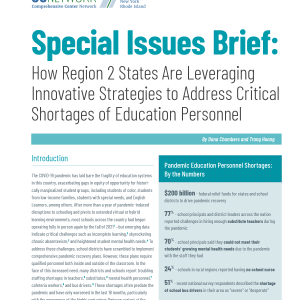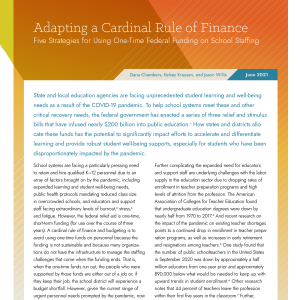Addressing the Teacher Shortage: Recruiting and Retaining Teachers—Q&A with WestEd’s Gretchen Weber
Posted on

Recruiting and retaining teachers is fundamental to supporting learning recovery. In this Q&A, Gretchen Weber, Senior Managing Director at WestEd, responds to questions many communities are asking about how to address the teacher shortage crisis.
Much of Gretchen’s work focuses on supporting the teaching profession through research, policy, and practice. As a Board Certified Teacher, she draws on her experiences in classrooms, schools, and districts to work on behalf of educators everywhere. She roots herself in the expertise of her colleagues who are in classrooms every day.
Can you describe the teacher staffing shortage crisis and its implications for students?
Teacher shortages have been a persistent issue for decades, as well as a complex challenge that affects districts and schools at a very local level. State-level or even national-level data may mask specific local challenges. Rural districts have been challenged by teacher shortages in the form of attraction, attrition, and turnover problems for decades. Even before the pandemic, the majority of states reported a lack of special education, math, science, CTE, and ELL teachers.
The implications for students are numerous and varied—imagine starting the school year in first grade with a string of substitute teachers (someone different every day) and then a long-term substitute who is there for 2–3 months before a permanent teacher is hired halfway into the school year. How much instructional continuity and community building has been happening for that group of learners?
Imagine a high school math class, let’s say 9th grade Algebra, taught by other teachers in the building who are filling in during their own planning periods because substitute teachers aren’t even available. How well are 9th graders learning the fundamentals of Algebra in preparation for next year’s math class, which is built on the concepts they need to learn this year? The potential for uneven instruction, inconsistent classroom management, varied behavioral expectations, intermittent or stalled progress toward academic goals, lack of foundational building blocks in specific skills or standards all put students further at risk in the next academic year for further academic and social gaps and challenges.
What are the root causes of the crisis? What can be done in the short and long term to address the causes?
The reasons are varied for why the education workforce is losing professionals. Many studies point to concerns about working conditions, including compensation. Some of the challenging working conditions cited as top reasons for leaving include lack of resources (e.g., instructional materials), facilities issues, and lack of administration support; most recently they also include concerns about safety, staffing shortages (e.g., not having school nurses, counselors, etc.), scrutiny of curriculum, and a noted increase in student chronic absenteeism and disruptive behaviors.
We continue to see the practice of placing our most inexperienced teachers in the most challenging classroom settings, and this practice is often disproportionately applied to teachers of color. Teachers of color are also more likely to report having to navigate antagonistic school cultures.
It is also still common to hear beginning teachers report they are not provided robust mentoring and induction programs for new teachers (ideally through their third year of practice). In some places, 50% of teachers will leave the profession before their 5th year. In a recent survey of teachers nationwide, the first annual Merrimack College Teacher Survey (which has taken the place of the MetLife Survey of the American Teacher), less than half say the general public respects them and views them as professionals (down from 77% in 2011).
One in five teachers who leave the profession cite financial reasons; on average, teachers make 20% less that other college-educated workers and even less than that average in 25 states. A report from the National Education Association found that starting salaries averaged $41,770 for the 2020–21 school year, a 4% decrease from the prior year when adjusted for inflation and the lowest in at least a decade.
The general public seems to share the view of teachers themselves. In the annual PDK Poll of the Public’s Attitudes Toward the Public Schools results were released at the end of August—asked if they would want a child of theirs to become a teacher, 62% of respondents said no, an all-time high. In 1969 when the poll began, only 15% said no. The reasons cited are mainly the challenges of the job and low pay.
Finally, we continue to organize and staff schools with a model of asking teachers to fill multiple professional roles for all learners with a staffing model that has looked pretty much the same for decades, while the job has changed, and the demands have significantly increased.
In the short term, we can provide stronger supports for teachers in their first five years and rethink where we place beginning teachers within districts and schools. We can rethink staffing models and create specialties within the profession, differentiate roles, and create career advancement options. Schools can focus on addressing facility and resources challenges and addressing the culture/climate of the workplace. Remember—teacher working conditions are student learning conditions; addressing challenges for teachers improves where students come to learn.
When you say our teacher talent pool is also the leadership talent pool, what do you mean?
Ninety-eight percent of principals were teachers before they shifted to school leadership roles. If we lose excellent and effective teachers from the teacher talent pool, it depletes the potential talent pool for school leadership. Without a rich talent pool for excellent and effective school leadership, we further put the teaching profession and our students at risk for positive outcomes. School leadership is one of the most important factors in school culture/climate and reasons why teachers stay rather than leave a school, and is the second most important school-based factor in student achievement. Effective teachers are the first!
What are federal, state, and local leaders doing to address the teacher staffing shortage?
Federal, state, and local leaders are implementing a whole host of various strategies—recruitment/retention bonus pay, offering housing support and student loan repayment. Some states have reduced their licensure requirements. In some places, states are even allowing veterans and other noncredentialed workers to step in as teachers. In some districts, they have reduced the school week to four days in an effort to entice teachers. Several states including New Mexico, Florida, Alabama, and Mississippi have tried to address or pre-empt shortages by raising teacher salaries.
How is WestEd working to address teacher shortages?
WestEd has projects all along the teacher workforce continuum. We are evaluating teacher residency programs to support better teacher preparation; we are convening state education agency (SEA) leaders to share solutions and strategies and how SEAs can play a role in supporting districts addressing shortages; we are providing resources for educators focused on mental health and well-being; we are working with districts on workforce diversification strategies and we are exploring compensation reform ideas.
What are differentiated staffing models? How can they be used to mitigate teacher shortages?
Differentiated staffing models organize teachers and their roles differently based on skill, expertise, curriculum demands, and, most importantly, student needs.
Next Education Workforce is a differentiated staffing model designed around building teams of educators with distributed expertise. This model also develops different and better ways to enter the profession, specialize and advance.
Opportunity Culture model is another example of differentiated staffing, where the roles of teachers are restructured to extend the reach of excellent, highly effective educators and provide a distributed model of multi-classroom leadership.
These models could be solutions to mitigating workforce shortages because they address several challenges regarding the demands of the job, provide the ability to pursue different career pathways, create more support for those new to the profession, increase collaboration/reduce isolation, and can differentiate pay to be commensurate with the role.
As a Senior Managing Director at WestEd, Gretchen Weber leads a portfolio of work in School Choice, Literacy, and Talent Development and Diversity. She co-authored From Great to Influential: Teacher Leaders’ Roles in Supporting Instruction, Guidebook for Distinguishing the Right Leader for Your School, and Toolbox for Distinguishing the Right Leader for Your School. She appears in the 2011 documentary American Teacher.


